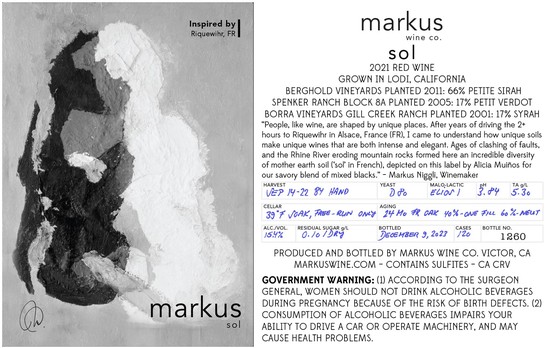Letters from Lodi
An insightful and objective look at viticulture and winemaking from the Lodi
Appellation and the growers and vintners behind these crafts. Told from the
perspective of multi-award winning wine journalist, Randy Caparoso.
Why Lodi blends are different and more terroir focused than blends grown anywhere else in the country
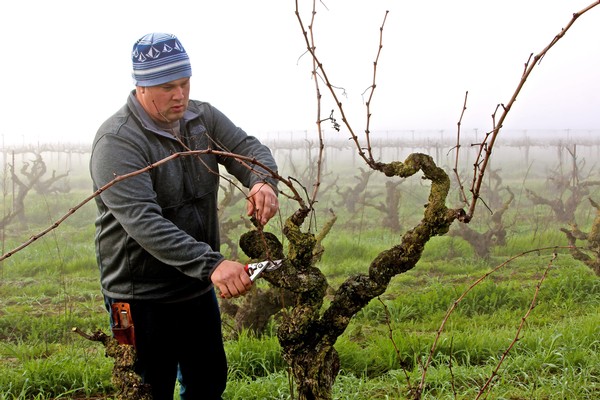
Sandlands owner/winemaker Tegan Passalacqua pruning 110-year old own-rooted Zinfandel in his Kirschenmann Vineyard.
It is almost funny that blended wines⏤wines made from multiple grapes⏤are so popular these days. For years and years the wine industry has been trying to convince consumers that the finest wines, at least those grown in America, are made from primarily one grape. These are called varietal wines. To be bottled as a varietal wine, according to federal law, a wine must be made from at least 75% of the grape listed on the label (allowing for up to 25% blending of other grapes).
The most popular varietal wines in the U.S. are Cabernet Sauvignon and Chardonnay. Other popular varietals include Pinot Noir, Merlot, Sauvignon Blanc (often bottled as Fumé Blanc), Pinot Grigio (a.k.a., Pinot Gris), and of course here in Lodi, Zinfandel.
Consumers, however, have not been satisfied with just varietal wines. Over the past 10, 15 years blended wines have become one of the country's most popular market categories. Blends are often sold, simply, as "Red Wine" or "White Wine," although most of the popular bottlings are sold under imaginative proprietary names.
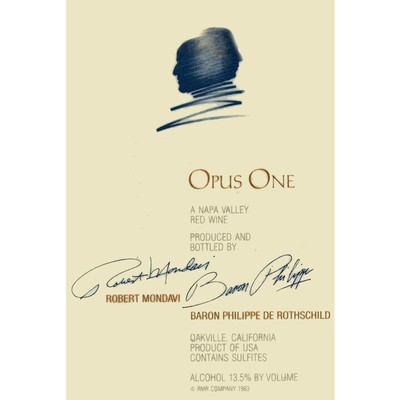
Classic label of an ultimate California blend.
For instance, one of the most famous California blends is called Opus One, a $400 (minimum) bottling from Napa Valley made primarily from Cabernet Sauvignon. The longtime inspiration of Opus One are the red wines of Bordeaux, which are almost always blends of multiple grapes such as Cabernet Sauvignon, Merlot, Cabernet Franc, Petit Verdot and Malbec.
Most popular, mass market California blends generally sell for less than $20, under labels such as Bread & Butter, Ménage à Trois, Apothic, 19 Crimes, and so forth; although brands such as Decoy, Orin Swift and The Prisoner retail closer to $25 to $50.
Lower priced red California blends are also squarely formulaic, sharing a common trait: They are usually perceptively sweet. Not very sweet, but nonetheless a little sweet, which emphasizes a soft, friendly fruitiness. The reason for this is simple: Wineries who produce these styles of wine are well aware of the fact that most consumers attracted to these wines prefer their wines to be a little sweet and fruity.
Even pricier blends, such as The Prisoner, tend to be intense in fruitiness, although The Prisoner's stock and trade is also one of extreme oakiness⏤strong aromas of vanilla, smoke, tobacco, char, etc.⏤because, simply again, fans of The Prisoner prefer a super-oaky red wine. In order for brands of blended wines to maintain their place in the marketplace, they need to retain consistent sensory markers that please their customers, no different than that of any other commercially defined adult beverage.
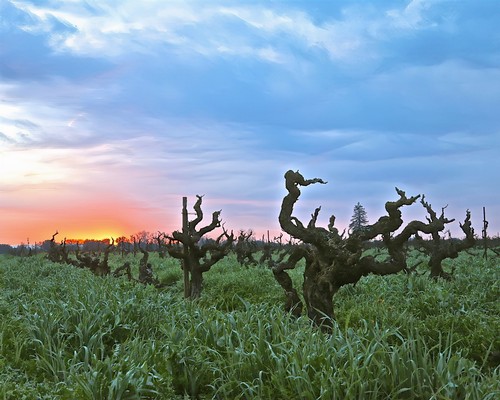
Wintering head trained Zinfandel in the historic Kirschenmann Vineyard, utilized in Sandlands' Lodi Red.
Lodi red wine blends⏤less commercialized, more about terroir
In Lodi, however, a number of slightly different styles of blended wines have emerged: Wines that are designed less to capture consistent sensory markers in order to compete in the crowded mass market, and more to capture a Lodi "sense of place." The opposite of formulaic.
The use of multiple as well as unorthodox (by conventional California standards) grape varieties is part and parcel of the emerging Lodi style of blends because of this unusual factor: There is a huge variety of grapes being grown in Lodi, a circumstance directly tied to the region's extremely grape-friendly Mediterranean climate and Delta influenced soils (grapevines thrive easiest in rich yet porous, well drained soils, which Lodi has aplenty).

Animal prints on the deep (down to 100 feet), fluffy, rich, fine sandy loam soil unique to Lodi's Mokelumne River AVA.
This is what we mean by the terroir (i.e., "sense of place") focused style of Lodi's style of blends. Blended wines from Lodi are meant to be direct reflections of the natural winegrowing conditions distinguishing the region, not styles of wine associated with brands.
There are, in fact, over 130 different grapes commercially grown in the Lodi AVA. Ever wonder why, also, Lodi has more "old vines" (i.e., vineyards over 50 years old) than any other region in California, hence the entire country? For the same reason why there are so many different grapes: Because the region's climate and soils are naturally conducive to long term grapevine health. It's as simple as that.
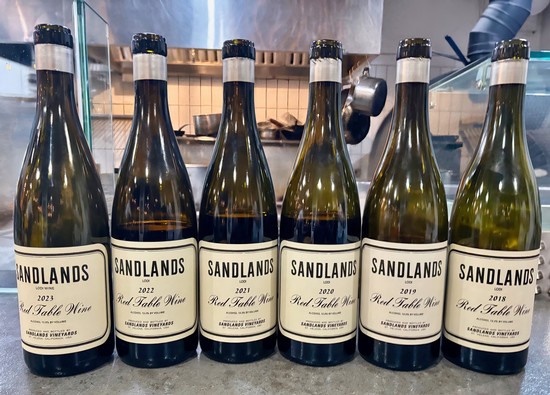
Recent vertical tasting (2018 through 2023) of the Sandlands Lodi Red Table Wine.
If Opus One still stands as an epitome of the artistry possible in blended wines grown in Napa Valley, one wine has stood out as something of an epitome of Lodi style blends: The Sandlands Lodi Red Wine. The name, obviously, is plain as can be, yet within the past five years this wine has attained a somewhat cult-like status (only in terms of the devotion it inspires, not inflated price) from coast to coast, despite the fact that its production amounts to just a few hundred cases (you won't find stacks of Sandlands Red splattered in wine stores across the country).
What distinguishes the Sandlands Red, in fact, is a consistency of components meant to resist sensory sameness: Each year, it is always made⏤in the most natural minimal intervention style possible (particularly, native yeast fermentation and practically zero oak influence)⏤from exactly the same proportions of Carignan, Cinsaut and Zinfandel (one/third of each grape). Therefore, each year the wine reflects nuances of vintage variations within the Lodi region itself.
Some years, for instance, the Sandlands Red is intensely fruit focused, perhaps more floral or fragrant, some years spicier with more pepper or kitchen seasonings than in other years, some years firmer, grippier or zestier in acidity on the palate, some years softer or more gentle on the palate, and so forth. The Sandlands Red always captures the slight bit of differences conferred upon the natural qualities of all three grapes dictated by Mother Nature herself, not a winemaker's machinations.
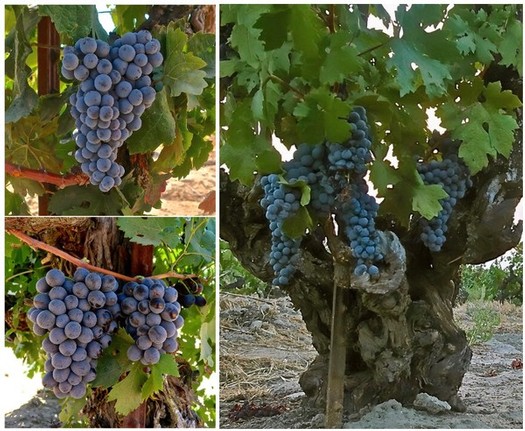
Clusters from the three vineyards going into the Sandlands Lodi Red each year (clockwise from top left): Carignan (Spenker Ranch, [planted in 1900), Zinfandel (Kirschenmann Vineyard, planted 1915) and Cinsaut (Bechthold Vineyard, planted 1886).
The significance of the three grapes going into the Sandlands Red is that they are the three varieties (Carignan, Cinsaut and Zinfandel) having the longest association with traditional Lodi winegrowing, going back over 100 years. They are emblematic of specifically Lodi. That in itself makes the wine very, very different from practically all other red wine blends made in California.
Still another factor is the fact that the Sandlands Red is sourced entirely from vineyards over 100 years old (the oldest planting is the Bechthold Vineyard Cinsaut, dating back to 1886!). A lot has been said about "old" or "ancient" vine plantings over the past ten years. What we know is this: The older a vineyard, the more likely a wine made from that vineyard will retain specific tastes unique to that vineyard⏤or what the French call terroir.
What it comes down to is this: Each year, the Sandlands Red is not made to retain a consistent depth of color, a distinctive oak-related marker, to be "big" in body, or "intense," "jammy" or "opulent"in fruit character. In fact, in most respects, it is always the opposite⏤delicate, refined, balanced, yet vibrant, and more earth toned than fruity or oaky, while retaining subtle sensory vintage variations. It is made to taste like a red wine grown in "Lodi." What a concept.
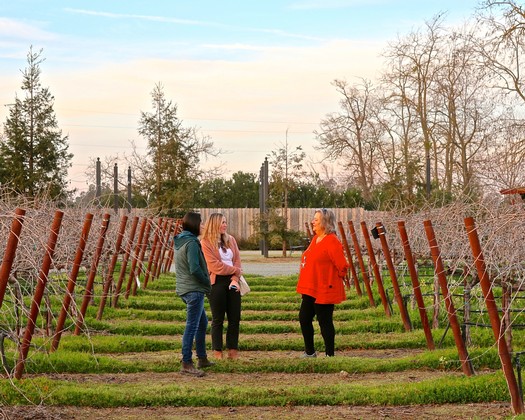
Acquiesce Winery owner/grower Sue Tipton (right) and winemaker Christina Lopez (left) chatting in estate with visiting journalist.
Why Lodi white wine blends are equally phenomenal
Believe it or not, the quintessential style of Lodi blend may not be a red wine at all, but rather a white wine. Standing head and shoulders above all others for the past ten years has been a white wine called Belle Blanc, grown and crafted by Acquiesce Winery, an estate originally conceived for the production of white wine blends inspired by those of France's Châteauneuf-du-Pape appellation. The current vintage, a 2023, is a Roussanne (50%) blended with Grenache blanc (30%) and Bourboulenc (20%).
Although sourced from a vineyard planted just 15 years ago, the beauty of Acquiesce's Belle Blanc is how the three grapes come together to express silken fine, fragrant and multifaceted qualities in both the nose and on a crisp, delicate (barely 13% alcohol), deftly layered palate feel, entirely unperturbed by external qualities such as oak (the Acquiesce style is 100% unoaked). White flower and stone fruit nuances mingle with smidgens of white pepper, green tea and an almost briny minerality.
Like liquid Zen meditation, the Belle Blanc is the exact opposite of the contrived fruitiness or cumbersome intensity typical of the vast majority of California wines of any color. Instead, it is all about natural sense of place: A Mediterranean-ish sun reflecting off the flat, fluffy sandy soils of Lodi's Mokelumne River appellation, pumping floral and Provençal-like herb flavors and textures into this wine. You can almost imagine an early nineteenth century English poet scribbling in the background. The idea is to glimpse natural taste of Lodi in this wine, not an amalgamation of specific grapes or predictable style of a brand.
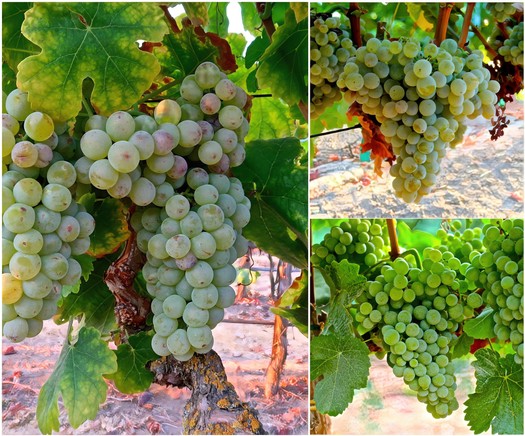
The three grapes going into Acquiesce's Belle Blanc (clockwise from left): Roussanne, Grenache blanc and Bourboulenc.
Roll call of extraordinarily unique Lodi blends
If you find these styles of blends intriguing, you would do well to investigate any of the following current releases, which capture similar uncommercial, yet Lodi-centric, qualities:
2022 Markus Wine Co., Mokelumne Glen Vineyards, Lodi Nativo ($25)⏤Almost breathtakingly airy and precise white wine blend of Kerner (91%) and Bacchus grapes⏤sleek, floral, minerally, contemporary yet wholly "classical" in its pinpoint feel.

Haarmeyer Wine Cellars' Craig Haarmeyer, a paradigm of alternative, terroir focused wines.
2023 Haarmeyer Wine Cellars, Mokelumne Glen Vineyard, Victor Weisser, Gemischter Satz ($28)⏤Incredibly unique, exotic, dry yet feathery light single-vineyard white co-fermented from no less than 52 varieties of German and Austrian origin.
2022 Acquiesce Winery, Mokelumne River-Lodi Belle Blanc ($43.50)⏤50% Roussanne, 30% Grenache blanc, 20% Bourboulenc⏤the acclaimed white blend that put Lodi's identity as a "Rhône" region on the map, extremely fine, fragrant, complex.
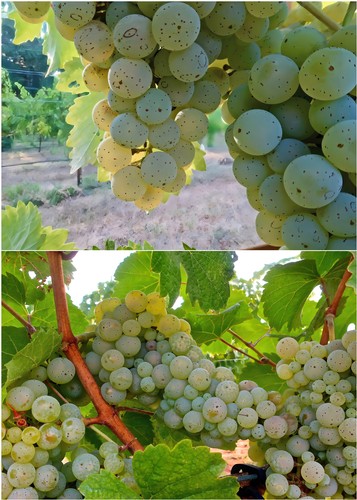
The two unique grapes of German origin going into Markus Wine Co.'s Nativo: Kerner (top) and Bacchus.
2023 Acquiesce Winery, Mokelumne River-Lodi Ingénue ($43.50)⏤Even more intense and multifaceted than this estate's Belle Blanc, this white wine blend is a rare combination of Clairette blanche (35%), Grenache blanc (20%), Bourboulenc (20%) and Piquepoul (10%).
2018 Bokisch Vineyards, Lodi Reserva Spanish Blend ($44)⏤While this estate is acclaimed for its varietal bottlings of Spanish grapes, this red demonstrates why the Spanish themselves prefer blends; showing how the wild, exotic taste of Graciano (59%) is tamed by suave, meaty Tempranillo (28%) while electrified by perfumey Carignan (13%), embellished by lavender/licorice-like terroir notes brought out by 4 years in neutral French oak.
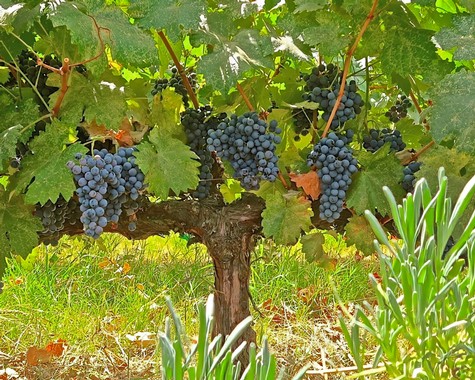
Bokisch Vineyards Graciano.
2021 The Bootleg Society (by St. Amant Winery), Speakeasy Red ($24)⏤Purely sensory, minimally oaked, supple yet intense, bouncy and joyously balanced qualities reflecting everything everyone loves about Lodi grown Zinfandel, Petite Sirah as well as the region's rich yet rounded styles of Cabernet Sauvignon.
2022 Perch Wine Co., Lodi Kestrel Red ($25)⏤Native yeast fermented, neutral oak aged blend of old vine Carignan, Zinfandel, Cinsaut and Petite Sirah, capturing an essence of Lodi terroir in an earthen/spice toned, long, rich, seamlessly knit package.
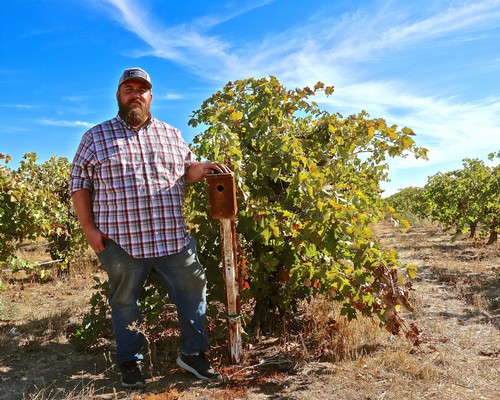
Nico Teresi in his regeneratively farmed Teresi Vineyard.
2021 Monte Rio Cellars, Mokelumne River-Lodi Teresi Vineyard ($26)⏤Although crafted in a natural style from younger vines, a stunning 50/50 blend that captures the zesty, floral, red berry scent typifying east side Lodi Zinfandel with the wild and rustic aromas and weight of Lodi grown Petite Sirah.
2022 Perlegos Family Wine Co., Lodi Duetto Red Wine ($26)⏤While inspired by red wine blends imported from Sicily, this wine is very "Lodi" by dint of its fresh, zesty black cherry infusion of Zinfandel (50%) with the more densely textured, compact, black fruit qualities of the native Sicilian grape known as Nero d'Avola. Unexpected, unique, captivating.

Second generation Lodi growers John (left) and Jeff Perlegos.
2022 Perlegos Family Wine Co., Lodi Red Wine Blend ($28)⏤This wine might be labeled, plain and simple, as "Lodi Red," but there's nothing plain or simple about it. It's actually an amazing blend of Merlot (adding a lush/plush black cherry layering), Cinsaut (ultra-bright kitchen spices and brambly red berries) and Carignan (super-zesty wild cherry), kept pure and fresh by strictly neutral barrel aging. Perfect example of why Lodi grown blends work so beautifully and effortlessly, while capturing the appellation's multifaceted (in this case, both historical and innovative) profile.
2022 Christopher Cellars, Grand Cuvée ($30)⏤This blend of old vine Carignan (50%), Zinfandel (25%) and Cinsaut (25%) rings in more than these grapes' varietal profiles. It hits the nail on the head as to exactly why these grapes have been cultivated for over 100 years in the appellation: Carignan bringing the refreshing acidity, Zinfandel a robust structure and mouth-feel, and Cinsaut an intoxicatingly spiced perfume, all wrapped up in velvet texturing.

Lodi's Mokelumne Glen Vineyards, planted to over 50 grapes of German and Austrian origin, going into extraordinarily unique blends such as Haarmeyer's Victor Weisser and Markus Wine Co.'s Nativo.
2022 Sandlands Wine, Lodi Red Table Wine ($38)⏤By acclaimed winemaker/grower Tegan Passalacqua, a masterful, terroir driven 1/3 blend of Cinsaut, Carignan and Zinfandel, sourced entirely from vineyards over 100 years old.
2021 Marchelle Wines, Mokelumne River-Lodi Family Cuvée ($39)⏤Handcrafted by the famed Sonoma Coast based winemaster Greg La Follette⏤a phenomenally finesseful, earth toned blend of ancient vine Carignan (Spenker Ranch's 1900 Block) and Zinfandel (Royal Tee Vineyard, planted 1889, the oldest mixed grape block in all of Lodi).
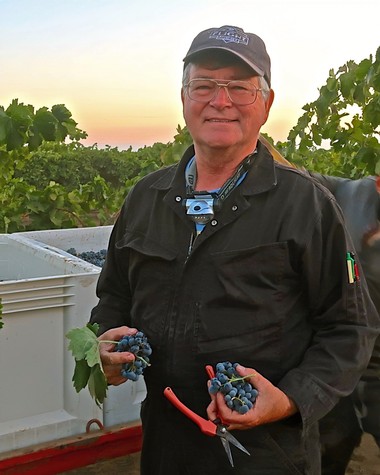
Winemaster Greg La Follette in Spenker Ranch's 1900 Block, the Carignan component of his Marchelle Family Cuvée.
2021 Markus Wine Co., The Church Block, Mokelumne River-Lodi Ancient Blocks ($41)⏤Monumental masterpiece of a single vineyard, native yeast co-ferment⏤pungent, powerful, full scaled yet absolutely velvety in texturing and even keeled feel⏤handcrafted from Carignan (56%), Petite Sirah (32%) and the rare Alicante Bouschet (12%), all from own-rooted vines dating back to the 1930s. Great example of how hands-off winemaking focuses on "place," not individual grapes or formulaic branding.
2021 Markus Wine Co., Lodi Sol ($41)⏤Owner/winemaker/grower Markus Niggli's métier is blends, producing a bewildering number of them each year—no wine or vintage really the same, an approach enhanced by a European predilection for minimal intervention. "Sol" suggests sun, one of Niggli's yearly mantras. In 2021 it is a meditation on Petite Sirah (66%), with which Niggli has always had an adroit touch, bringing out the opulence and complexity possible in the grape under Lodi sun by blending Petit Verdot (17%) and Syrah (17%)⏤the latter, a far better complement (adding velvety and liqueur-like violet, lavender and black olive intensity) to musclebound Petite Sirah than assumed by most of the California wine cognoscenti.
